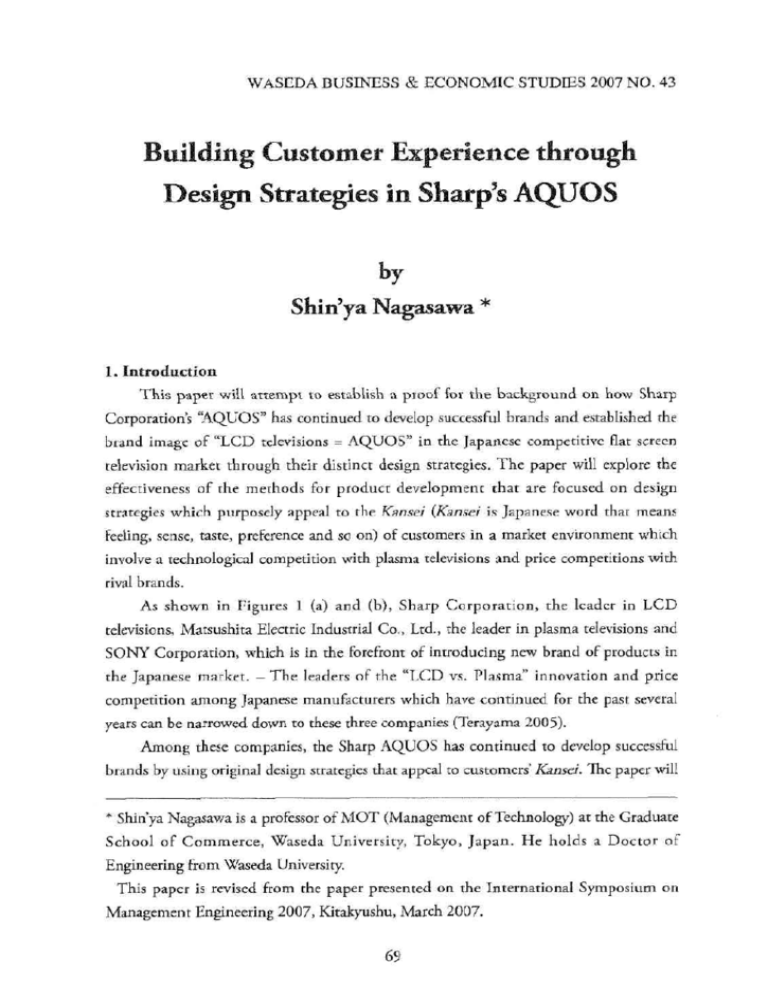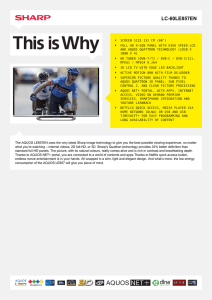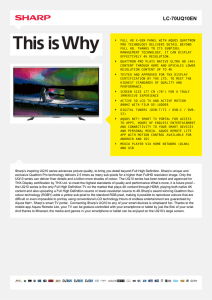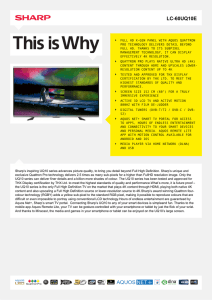Experience through in Sharp's AQUOS
advertisement

WASEDA BUSINESS Bui Wing Customer esign Strategies & ECONOMIC STUDIES 2007 NO. 43 Experience through in Sharp's AQUOS by Shin'ya Nagasawa 1. Introduction This paper will attempt to establish a proof for the background on how Sharp Corporation's "AQUOS" has continued to develop successful brands and established the brand image of "LCD televisions = AQUOS" in the Japanese competitive flat screen television market through their distinct design strategies. The paper will explore the effectiveness of the methods for product development that are focused on design strategies which purposely appeal to the Kansei (Kansei is Japanese word that means feeling, sense, taste, preference and so on) of customers in a market environment which involve a technological competition with plasma televisions and price competitions with rival brands. As shown in Figures 1 (a) and (b), Sharp Corporation, the leader in LCD televisions,Matsushita Electric Industrial Co., Ltd., the leader in plasma televisionsand SONY Corporation, which is in the forefront of introducing new brand of products in the Japanese market. - The leaders of the "LCD vs. Plasma" innovation and price competition among Japanese manufacturers which have continued for the past several years can be narrowed down to these three companies (Terayama2005). Among these companies, the Sharp AQUOS has continued to develop successful brands by using original design strategies that appeal to customers' Kansei. The paper will * Shinya Nagasawa is a professor of MOT (Management of Technology) at the Graduate School of Commerce, Waseda University, Tokyo, Japan. He holds a Doctor of Engineering from Waseda University. This paper is revised from the paper presented on the International Symposium on Management Engineering 2007, Kitakyushu, March 2007. 69 Figure1: MarketShare of Flat ScreenTelevisionin Japan (2005) (a) LCDtelevisions JVC Others nr Toshiba ` z _- ixxY"#~~" (b)PlasmaTelevisions Others Pioneer to she °%rp Matsushlts " SO to ,u Hitao zac --Metsushlte Source- Association of Eleetmeommunlcason Engineering Industries ofJapan take a close look at AQUOS's design strategies by conducting an interview with Mr. Takashi Okuda, corporate director of Sharp's audio-visual systems SBU (strategic business unit) who was in charge of development to ask him his rationale behind the design strategies. In addition, examination will be held on whether AQUOS's design strategies effectively appeal to their customers' Kansei by examining the relationship between the values which appeal to their customers' Kansei and their design strategies by conducting an analysis using Prof. B.H. Schmitt's Experiential Marketing Framework (Strategic Experiential Modules). 2. Outline of Sharp AV business activities Sharp finished in 6th place in the market share rankings only because they did not own any televisions despite the fact that in 1953 they sold the first ever television in Japan. In 1998, Mr. Katsuhiko Machida, the former CEO of Sharp, who had gone through such bitter experiences,announced that "All domestically sold televisionswould be replaced by LCD televisionsby the year 2005." (Tachizawa2003) The LCD television, which was developed for the purpose of achieving this goal, was the AQUOS television. AQUOS televisions went on sale in 2001 and were a great success, capturing about a 40% share of the domestic market for LCD televisions.Sales and operating profits have shown a double-digit growth every year and the operating profit margin increasedfrom 4% in 1999 to 5.9% in 2005. The reason Sharp has been able capture a large share of the market for LCD televisions is largely because they were able to establish their brand image of "LCD televisions = AQUOS" in the market. The reason Mr. Okuda, who was in charge of the development of the AQUOS television,continues to be particular about brands, creation, and their promotion is because he has learned through his bitter experiences during the CRT era that even if they a good product, they cannot sell it without a brand. 70 3. AQUOS's design strategies Based on the interview with Mr. Okuda, AQUOS's design strategieswere organized into the three categories of `product design", "promotional design", and "point of sales design." 3.1 Product Design The role of AQUOS is to replace the CRT televisionmarket with LCD televisions. As a design strategy for achieving this goal, new values needed to he expressedthrough the design of the product. Sharp's solution was to have the product design be completed, not by an in-house designer within the company but by an outside designer. They decided to entrust the job to world-class furniture designer Toshiyuki Kita. The new value driver for LCD televisions,which Mr. Okuda had in mind, was to treat them as interior decor. His aim was to change the designs from those of conventional electrical appliances by creating a design that would allow the television to fit into a room as a piece of furniture. As part of the pursuit for such an effect,the most important element of the design of the AQUOS televisionwas in the leg (stand) design. It was designed based on Mr. Kitas idea that humans and cranes present the most beautiful standing postures. It was especially the design of the C Series (see Figure 2(a)), the first series introduced, which firmly established the image of LCD televisions = AQUOS to the general public. It clearly created a visual impact that cannot be felt with CRT based televisions.In fact, this design for the AQUOS televisionwas used in a newspaper ad in 2001 and had a tremendous impact. Along with the words "What did you see during the 20th Century? What would you like to see during the 21st Century?", the ad depicts a young girl who is looking into a black and white television and in contrast, the most Figure 2: Sharp's AQUOSSeries (a) AQUOSC series (b)AQUOSBSeries a s *' y ~Tn. I ~" a x .Source.5barp Corperatlan 71 famous actress Sayuri Yoshinaga,who is standing while holding an AQUOS televisionin her hand. This ad was successfulin creating a completelynew type of visual impact. The AQUOS television, which Kita has filled with the values of interior decoy has become globally recognized.In 2001, it was selected as part of the permanent collection at such places as Pompidou Centre in Paris, the State Gallery of Modern Art in Munich and the Museum of Art and Design in Hamburg. The furniture design approach is succeededas shown in Figure 2(b) in spite of some model-changes. 3.2 Promotional Design The promotional planning for the AQUOS television began with Mr. Machida's announcement in 1998 when it had been conditionally decided that the AQUOS television would emerge as a next generation television that would replace the CRT television. Mr. Okuda expressed this sensation as "launch impact." 'Ihe words "launch impact" express the entire concept of the promotional design for the AQUOS television. In the case of AQUOS televisions, it is the series commercial casting Ms. Sayuri Yoshinagawhich has had the greatestinfluence in terms of "visual impact." Moreover,this series of commercials does not merely advertise a product, but rather it designs a space where customers can experience their "first encounter" with the AQUOS television. During the ten-plus seconds of encounter with customers, the commercial attempts to convey the emotions of "surprise" and "sense of reassurance" towards the AQUOS television. The feeling of "surprise"emerges because an AQUOS television has suddenly been placed in a world-class building and housing (see Figure 3). 'the AQUOS television displays a presence, which is competitive with first class buildings of the world. The maverick qualities of Ms. Sayuri Yoshinaga standing next to the television and her narration playing in the background create a sense of reassurance towards the product. Her voice has the ability to erase any doubt that people may have and a sense of sincerity can be felt throughout her message.As this commercial is aired repeatedly, the launch impact will continue to increase. This commercial series,finished in first place in the "Survey of Popularity Ratings for Product Commercials among Women in their Sixties"which was conducted in June, 2005 by CM Database, beating 3032 popular commercialssuch as the one for Suntory's lemon tea. 72 Figure 3: An example of AQUOS's series commercial casting Ms. Sayuri Yoshinaga: Modern Sansui no N/wa (Zen Scenery Garden) version + Source: Sharp Corporation 3.3 Point of Sale Design The promotional planning for the AQUOS television began with Mr . Machida's announcement in 1998 when it had been conditionally decided that the AQUOS television would emerge as a next generation television that would replace the CRT television, Mr. Okuda expressed this sensation as "launch impact." The words "launch impact" expressthe entire concept of the promotional design for the AQUOS television. As it turned out, the majority of AQUOS televisions ended up being sold at mass merchandise stores, where the manufactures had very little control. This means that the manufactures could not "serve" customers directly. As for the current state of point of salesat mass merchandise stores for home appliances,although some sales personnel may 73 give customers a description of the product, the story behind the hard work of the designers and engineers when creating the product is often left out. Most often, there description ends up being nothing more than a comparison of specifications and capabilities (Kawashima 2005). It is in such circumstances that Sharp is making efforts to design the points of sales. Although such things as the planning store fixtures and designing popup displays were a part of the design effort, Sharp's main focus was to create a point of sale video which encourages sales personnel to say"AQUOS televisionshave the clearest picture." The production for this promotional video films was handled mainly by Mr. Okuda. It is also worth noting here that rather than asking the advertisement staff within the company to do the job, Sharp chose to hire talented artists from outside of the company such as CG director Daizaburo Harada and musician Tetsuya Komuro to complete the task. In addition, it is also interesting that they chose not to use an advertisement agency but rather, they chose to shape their plans by discussing their ideas with one another. Sharp has also made great efforts to add to the aesthetic beauty of the product. They have attempted to recreate analogimages and sound by using their original single bit recording and a high vision camera (see Figure 4). Mr. Okuda's aim was to show the stories behind the hard work the designers and engineers put into creating the product, which can be expressed not by sales representatives,but through the AQUOS televisionspeaking for itself. Sharp was the only company at the time the LCD television was released to develop this type of promotional video. The promotional video, which was created for the purpose of displaying the beauty of the AQUOS television, brings about a launch impact Figure 4: An example of AQUOS's promotional video films directed by Daizaburo Harada: Neiro (Sound Tone) Version Source: Sharp Corporation 74 against rival companies at the point of sales of mass merchandise stores. There is little doubt that this promotional video, which was made by a group of talented personnel with great technology, is often what drives Japanese customers, who are very particular about the picture quality, to make the purchase. Sharp valued the importance of the launch impact even before the AQUOS television was released.At the time the AQUOS televisions were first introduced, there was especiallya need to combine development, production and sales into one effort in order to release the product. In order to do this, Sharp formed a team of experts, `the AQUOS Preachers", in order to convey the virtues of LCD televisions that are not available with CRC based televisions (Yanagiharaand Okubo 2004) . 3.4 Summary As it is described above, the product development strategies for the AQUOS television were not focused on advertising differencesin prices and functions but rather, on design strategies that appeal to the Kansei of customers by using the concept of "l aunch impact". In thinking of ways to stimulate the Kansei of customers by increasing the feeling of launch impact of the product, Sharp has come up with their own comprehensive design strategy which not only includes the product design but also an opportunity for the customer to "encounter" the product for the first time and a point of sales which focuses on customer service. Moreover, in employing topnotch technology and personnel for each design element, it is clear that Sharp, as a manufacturer, tries everything that is humanly possible in designing a great product. Mr. Okuda's aim was to provide customers with the AQUOS television as a wonderful "dish" cooked with the best ingredients of Sharp'sLC technology and made by wonderful chefs such as designer Toshiyuki Kita, actress Sayuri Yoshinaga, CG director Daizaburo Harada and musician Tetsuya Komuro. 4. A Customer Experience Analysis of the AQUOS television Prof. Bernd H. Schmitt of Columbia University refers to the value that appeals to people's Kansei when they have contact with a company or brand and feel a realistic emotion or some sort of sensation as "customer experience." Schmitt has categorized customer experienceinto 5 Strategic Experiential Models (SEMs) in order to apply it to marketing as a strategic basis (Schmitt 1999). The values, which make the AQUOS television appealing to the Kansei of customers, are examined by categorizing the values which it possesses using the Strategic 75 Table1:TheCustomerExperience of AOUOS Televisions According to Schmitt'sStrategic Experiential Modules(SEMs) Modules!: Customer Experenceof_AQUOS Televisions YSENSE • Surprise towardsToshiyuki Kita'suniquedesign • Surprise towardstherealistic andbeautiful picture onthe bigflatscreen. • A sense of reassurance felt towards the product from Ms . Sayuri Yoshinaga's commercial. • A sense of reassurance felt towards the quality of the product because ii was manufactured at Kameyama Plant. Admiration towards environmentally friendly products AC7 RELATE • Anticipation of a futuristic lifestyle I • Sense of importance felt from communicating on a members' rs only weDpage. webpage. Source: Nagasawa, Shin'ya (2007) "Customer Experience Creator -Sharp AQUOS's Design Strategies Appealing to Customers' Kansei -," Proceedings of international Symposium on Management Engineering 2007, R2, p.4, Table I. Ex periential Modules. The categories for each model are shown in the table below (see 'I" , ble I). 4.1 SENSE (Sensory Customer Experience) For the category of "Sense", there are two surprises that are contributing factors. One surprise was the unique design and as mentioned previously, the designing was entrusted from the developing stage to world-class furniture designer Toshiyuki Kita. The second surprise was the beauty of the picture. In order to convey the beauty of the picture to users, as mentioned previously, a unique promotional video was created, which has been thought through so well it may even be considered obsessive. 4.2 FEEL (Affective Customer Experience) For the category of "Feel", there are two instances of reassurance that are contributing factors. The first instance of reassurance, as mentioned previously, is the feeling of reassurancethat was felt towards the product through Ms. SayuriYoshinaga'scommercial. Sharp was able to improve the brand image of the AQUOS television by using the character of Ms. Sayuri Yoshinaga strategicallyand effectively.Sharp actually began using Ms. Sayuri Yoshinaga for their commercials a year before the actual release of the AQUOS television as a pre-launch ad campaign. Sharp had been using Ms. Yoshinaga Sayuri as a theme model in an aim to get people accustomed to the idea that the era of CRT televisionswould be over and a new LCD era would begin. In order to achieve this, they had her say the words "What to leave in the 20th century? What to take into the 76 21st Century?" in a commercial even before the release of the AQUOS television.These were strategic messagesfilled with Sharp's intention of leaving the CRT era behind and entering a new LCD era. The second instance of reassurance, as mentioned previously, is the feeling of reassurance towards the quality of the product because AQUOS was manufactured at Kameyama Plant (see Figures 5 and 6). Sharp, in order to build LCD televisions with the best quality, has invested roughly Figure 5:Sharp's KameyamaPlant V ~ xD ~q ~1a Source: Sharp Corporation Figure 6: Examples Kameyama 'tta a , of atttR~enM. of AQUOS's ads which all had the photo and explanation of Plant $MA .. t$ soNt U `n'om,uAa 4i. SHARP s aria ry sx. .,, AQUOS AQUOS Source: Sharp Corporation 77 V 300 billion yen in constructing the Kameyama Plant where the entire manufacturing process, from the production of the LCD panels to the completion of the television, can be done. At a time when manufacturing businesses were moving their worksites to overseas locations such as China, Sharp headed in the opposite direction and built a stateof-the-art manufacturing plant. Kameyama plant created a legend as the epitome of Japanese creation. In fact, Sharp places popup displays which have been fabricated at Kameyama Plant on products at the point of sales much like regional vegetable brands and appeal the quality of their products towards customers. 4.3 THINK (Creative/Cognitive Customer An increased interest in environmentally with the category of "Think'. watching television Experience) friendly products is one example involved In the past, customers had never associated the act of with environmental issues. However, because of successive environmental ads which all had the copy "Let's go on ecology class. Sharp.", customers have come to believe that buying and using an LCD TV would allow them to begin an Figure 7: An example of AQUOS's environmental the copy "Let's go on ecology Kameyama Plant class. ads Sharp:' r P which and all had photo of All sk k~ a I I o) M1 4._,31 V t. Source. Sharp Corporation 78 environmentally friendly lifestyle(see Figure 7). 4.4 ACT (Physical Customer Experience) The category of "Act" involves the anticipation that out lifestylewill change into a futuristic one. The fiat screen televisions which appeared in old science fiction movies, hanging on the walls as futuristic objects, have become a reality. Now that it fits into die living space, it changes the way time flows in the mom and people even feel like their lifestylehas been upgraded. In fact, there is now a brand new demand for AQUOS televisions,which include the new value of interior decor. This is a demand for information value as seen in consumers who switching over from CRT based televisions to LCD televisions when building or renovating a home. Consumers are buying new LCD televisions,not because their old televisions broke, but because they want a new television with a design suitable for their living or working space. 4.5 RELATE (Social-identity customer experience) An example of "Relate" is the space for communication on Sharp's buyer's only website "Owner's Lounge Buyers of an AQUOS television can register for membership by entering the serial number of their television. In this owner's lounge, owners of AQUOS televisions can either communicate with Sharp or with other AQUOS owners. Ia either case, this service makes the user feel important because they haveaccessto information that is only available to members. 4.6 Summary In making an analysisusing the strategic experiencemodel in the above fashion, I was able to confirm that the three components of design strategies were included in the data and corresponded with the strategic experiencemodel. In addition, it is worth noting here that for the design strategy components are the same points that are described as the characteristics making AQUOS televisions unique especially in comparison with other strategic experience models. 5. Analysis In making a value analysis using the design strategies for the AQUOS television which appeal to the Kansei of customers and Prof. B.H. Schmitt's five modules of customer experience, a strong correlation was confirmed between the three types of 79 design strategiesand the categories of "Sense", "Feel"and "Act"in the strategic experience modules. As for the first design strategy,a correlation between the superb designs and creation efforts, which have been made by thoughtful ideas based an technology, was confirmed. In particular, designer Toshiyuki Kita's original and innovative design expresses anticipation for a change in our lifestyle and directly appeals to the five senses of customers. This correlates with the customer experience of "Sense", which emerges through our senses. As for the second design strategy, "the encounter space design", a relationship was confirmed between the design strategy and the fact that Sharp has been able to achievea "l aunch impact" which involvesan encounter with customers while expressing the value of their product to the maximum extent possible.Among these encounters, the one that has had the greatest "launch impact" has been Ms. Sayuri Yoshinaga'scommercial series, which serves as the customers' first encounter with the AQUOS television. In addition, the thoughts of die creators can be felt through out the commercial, which correlateswith "Feel", the emotional type of customer experience. As for the third design strategy, "the point of sales design", Sharp, in order to give customers a feeling of surprise and importance, has worked hard in creating a point of sales while always looking ahead to the future. In addition, as final motive to drive customers to make the purchase, Sharp gives customers a feeling of surprise with a promotional video which has been produced by a collection of topnotch professionalsand use the slogan "AQUOS has the best picture" to guide their customer in making the purchase. The contact with the product correlates with the physical type of customer experience. Finally, the information arising when creating the first design strategy, "product design', transforms into a fund of knowledge that is used to indirectly expressthe hard work that went into the creation of the design. This correlateswith "Think", the creative/ cognitive type of customer experience as information to be used to display particular experiences or feelings of importance from other components such as "encounter space and "space for serving customers". Although generally speaking, this type of information is often just technological information which is hidden in the product, it is possible to make use of this valuableinformation by implementing product development plan which is conscious of a wide range of "encounter space" and "space for customer service". The concept of the correlation between the design strategies for the AQUOS television and the 5 models of customer experience are shown below (Figure 8). 80 Figure 8:The Relationship AQUOS Television between the Design Strategies for and the Customer Experience Model the Source: Nagasawa, Shin'ya (2007) 'Customer Experience Creation - Sharp AQUOS's Design Strategies Appealing to Customers' Kansei -," Proceedings of International Symposium on Management engineering 2007, R25, p.6, Figure 2. 6. Conclusion In examining the relationship between the components of the design strategies for the AQUOS television and the customer experience model, it was confirmed that the design strategies for the AQUOS televisioneffectivelyappeal to the Kansei of customers. The real world example of the AQUOS televisions, which have become a long running successbased on design strategy focusing on the customers' senses, not only can be applied to the LCD television market, but serves as good example for other industries involve in price competition. Sharp's AQUOS television has created a new demand for televisions as interior decor. Moreover, in analyzing the AQUOS television in terms of customer experience, each of the categories of "Sense", "Feel", "Think", "Act"and "Relate" have been furnished to a high standard and the AQUOS television can be considered a conglomeration of customer experience. Furthermore, in analyzing and exploring AQUOS televisions as an example of a creation of customer experience, it can be clearly explained based on Schmitt's categorization of customer experience. Consequently, these ideas will serve as a great referencein advancing product development. 81 References Kawashima,Yoko(2005) DesignStrategyof Matsushita Electric, PHP Institute. (in Japanese) Nagasawa, Shin'ya ed. (2005) ValueCreation through Customer Experience That DevelopsHit Produces:ProductionThat Influencingon Human Kansei,NikkagirenShuppansha.(inJapanese) Nagasawa, Shin'ya (2006) "Management of Technology (MOT) and Customer Experience," ProceedingsoflnternationalSymposiumon ManagementEngineering 2006, R20, pp.1-8. Nagasawa, Shin'ya ed. (2006) Creating Customer Experience in Long Standing Companies:DesignManagementof GlanceofCustomer,Doyukan.(inJapanese) Nagasawa,Shin'ya ed. (2007) Manufacturingand Fabrication by Creation through CustomerExperience:Implementationof "Intangibles"ThatProducesBrand Value and Hit products,NikkagirenShuppansha.(inJapanese) Nagasawa,Shin'ya (2007) "CustomerExperienceCreation - Sharp AQUOS's Design Strategies Appealing to Customers' Kansei -," Proceedingsof International Symposiumon ManagementEngineering2007, R25,pp.l-6. Nagasawa,Shin'yaand TakaoSomeya(2007)Traditionand Innovationat LongStanding Brand "Toraya":BuildingCustomerExperienceand TechnologyManagement, Koyoshobo.(inJapanese) Schmitt, Bernd H. and Alex Simonson(1997) Marketing Aesthetics: The Strategic Managementof Brands,Identity,and Image,FreePress. Schmitt, Bernd H. (1999)ExperientialMarketing:How to Get Customersto SENSE, FEEL,THINK, ACT and RELATEto YourCompanyand Brands,FreePress. Schmitt, Bernd H. (2003) Customer Experience Management: A Revolutionary Approachto Connectingwithyour customer,John Wiley& Sons. Tachizawa,Koji(2003)Sharp'sOnlyOne Management,OS Publishing.(in Japanese) 82 Terayama, Shoichi (2005) Final War of LCD vs.Plasma," Nikkei BR (in Japanese) Yanagihara,Kazuo and Takahiro Okubo (2004) Sharp's "Stock"Management, Diamond Inc. (in Japanese) 83







